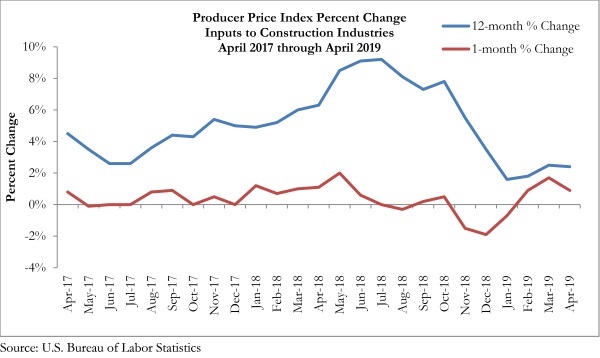Construction input prices increased 0.9% in April on a monthly basis and 2.4% compared to the same time last year, according to an Associated Builders and Contractors analysis of U.S. Bureau of Labor Statistics data released today. Nonresidential input prices rose 0.9% compared to March and are up 2.8% on an annual basis.
Among the 11 sub-categories, seven experienced price decreases last month, with the largest decreases in natural gas (-8.7%), iron and steel (-1.7%), and steel mill products (-1.7%). The four sub-categories that experienced monthly price increases were crude petroleum (+13.9%), unprocessed energy materials (+3.7%), prepared asphalt products (+2.7%) and concrete products (+1.1%). Year over year, prepared asphalt products (+7.5%), steel mill products (+5.8%) and plumbing fixtures (+4.3%) experienced the largest price increases.
“Even though April was the third consecutive month that input prices increased and overall materials prices remained elevated, there is little reason for contractors to be on high alert,” said ABC Chief Economist Anirban Basu. “The increase in materials prices was primarily driven by higher energy prices. In particular, the price of oil mainly rose for political reasons, and therefore is not an indication that materials prices will aggressively increase.
“What’s more, the year-over-year increase in construction input prices is a mere 2.4%, which is only slightly higher than overall inflation and a bit lower than wage growth,” said Basu. “With much of the global economy slowing and given ongoing trade tensions between American and Chinese policymakers, it’s likely materials price increases will remain modest going forward, even in the context of a robust nonresidential construction sector.
Related Stories
Industrial Facilities | Apr 14, 2022
JLL's take on the race for industrial space
In the previous decade, the inventory of industrial space couldn’t keep up with demand that was driven by the dual surges of the coronavirus and online shopping. Vacancies declined and rents rose. JLL has just published a research report on this sector called “The Race for Industrial Space.” Mehtab Randhawa, JLL’s Americas Head of Industrial Research, shares the highlights of a new report on the industrial sector's growth.
Codes and Standards | Apr 4, 2022
Construction of industrial space continues robust growth
Construction and development of new industrial space in the U.S. remains robust, with all signs pointing to another big year in this market segment
Reconstruction & Renovation | Mar 28, 2022
Is your firm a reconstruction sector giant?
Is your firm active in the U.S. building reconstruction, renovation, historic preservation, and adaptive reuse markets? We invite you to participate in BD+C's inaugural Reconstruction Market Research Report.
Industry Research | Mar 28, 2022
ABC Construction Backlog Indicator unchanged in February
Associated Builders and Contractors reported today that its Construction Backlog Indicator remained unchanged at 8.0 months in February, according to an ABC member survey conducted Feb. 21 to March 8.
Industry Research | Mar 23, 2022
Architecture Billings Index (ABI) shows the demand for design service continues to grow
Demand for design services in February grew slightly since January, according to a new report today from The American Institute of Architects (AIA).
Codes and Standards | Mar 1, 2022
Engineering Business Sentiment study finds optimism despite growing economic concerns
The ACEC Research Institute found widespread optimism among engineering firm executives in its second quarterly Engineering Business Sentiment study.
Codes and Standards | Feb 24, 2022
Most owners adapting digital workflows on projects
Owners are more deeply engaged with digital workflows than other project team members, according to a new report released by Trimble and Dodge Data & Analytics.
Market Data | Feb 23, 2022
2022 Architecture Billings Index indicates growth
The Architectural Billings Index measures the general sentiment of U.S. architecture firms about the health of the construction market by measuring 1) design billings and 2) design contracts. Any score above 50 means that, among the architecture firms surveyed, more firms than not reported seeing increases in design work vs. the previous month.
Market Data | Feb 15, 2022
Materials prices soar 20% between January 2021 and January 2022
Contractors' bid prices accelerate but continue to lag cost increases.
Market Data | Feb 4, 2022
Construction employment dips in January despite record rise in wages, falling unemployment
The quest for workers intensifies among industries.



















